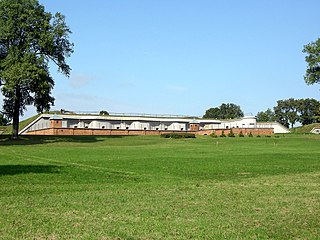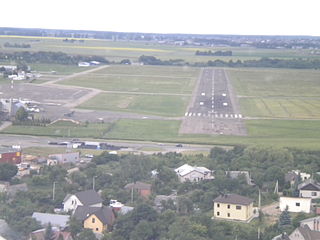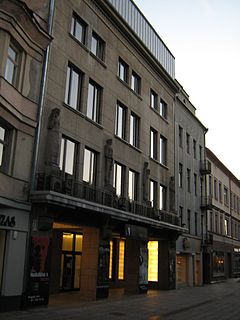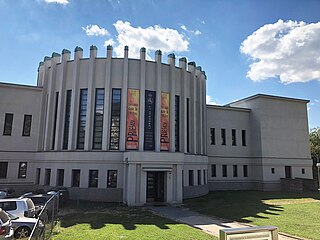This article provides an overview of telecommunications in Lithuania, including radio, television, telephones, and the Internet.

The Ninth Fort is a stronghold in the northern part of Šilainiai elderate, Kaunas, Lithuania. It is a part of the Kaunas Fortress, which was constructed in the late 19th century. During the occupation of Kaunas and the rest of Lithuania by the Soviet Union, the fort was used as a prison and way-station for prisoners being transported to labour camps. After the occupation of Lithuania by Nazi Germany, the fort was used as a place of execution for Jews, captured Soviets, and others.

Vilnius Airport is the international airport of Vilnius, the capital of Lithuania. It is located 5.9 km (3.7 mi) south of the city. It is the largest of the three commercial airports in Lithuania by passenger traffic. With one runway and 5 million passengers a year. Vilnius International Airport serves as a base for airBaltic, Ryanair, and Wizz Air. The airport is managed by state-owned enterprise Lithuanian Airports under the Ministry of Transport and Communications.

Kaunas is the second-largest city in Lithuania after Vilnius and an important centre of Lithuanian economic, academic, and cultural life. Kaunas was the biggest city and the centre of a county in the Duchy of Trakai of the Grand Duchy of Lithuania and Trakai Palatinate since 1413. In the Russian Empire, it was the capital of the Kaunas Governorate from 1843 to 1915.

Kaunas University of Technology is a public research university located in Kaunas, Lithuania. Established in 1922, KTU has been one of the top centers of Lithuanian science education. According to Lithuanian National University Rankings conducted in 2021, KTU was the second best university in Lithuania. The primary language of education is Lithuanian, though there are courses that are taught jointly in Lithuanian and English or solely English.

Centras is an elderate in the city of Kaunas, Lithuania, based on two neighbourhoods of Kaunas - the Old City and the New City. It lies at the confluence of two major Lithuanian rivers, the Nemunas and the Neris. The borough borders Žaliakalnis in the north, Šančiai in the east, Aleksotas in the south and Vilijampolė in the west.

The House of Perkūnas is one of the most original and Gothic secular buildings, located in the Old Town of Kaunas, Lithuania. Originally built by Hanseatic merchants and served as their office from 1440 until 1532, it was sold in the 16th century to the Jesuits who had established a chapel there in 1643. The Jesuits have also completed the Church of St. Francis Xavier at the Town Hall Square in 1722.

Cathedral Basilica of apostles St. Peter and St. Paul of Kaunas is a Roman Catholic cathedral basilica in Kaunas, Lithuania.

S. Darius and S. Girėnas Airport, also known as Aleksotas Airport, is a small airport located in Aleksotas district of Kaunas City (Lithuania), about 3 kilometres South-west from city centre. On May 6, 1993, the airport was named after the Lithuanian pilots Steponas Darius and Stasys Girėnas, who perished in a crash near the end of an attempted non-stop flight from New York to Lithuania in 1933.

The NationalKaunas Drama Theatre is the biggest theatre in Kaunas, and one of the oldest functioning theatres in Lithuania. There are six different creative spaces for events in the Kaunas Drama Theatre.

The Vytautas the Great War Museum is a museum in Kaunas, Lithuania. It was built in Art Deco and early functionalism style.

The Town Hall of Kaunas stands in the middle of the Town Hall Square at the heart of the Old Town, Kaunas, Lithuania.The structure dates from the 16th century. It houses a Museum of Ceramics.

The Historical Presidential Palace is a Neo-baroque building in the Old Town of Kaunas, Lithuania that served as the Presidential Palace during the interwar years. Today, the palace is a branch of the M. K. Čiurlionis National Art Museum.

Kaunas Fortress is the remains of a fortress complex in Kaunas, Lithuania. It was constructed and renovated between 1882 and 1915 to protect the Russian Empire's western borders, and was designated a "first-class" fortress in 1887. During World War I, the complex was the largest defensive structure in the entire state, occupying 65 km2 (25 sq mi).

The M. K. Čiurlionis National Art Museum is a group of museums based in Kaunas, Lithuania. It is primarily dedicated to exhibiting and publicizing the works of the painter and musician M.K. Čiurlionis (1875–1911).
Robertas Antinis is a Lithuanian Sculptor, performance artist and poet. He is a winner of the National Culture and Art Prize.

Siručiai Palace is a late Baroque mansion in the Kaunas Old Town, which was built in 1742 by Kaunas city court foreman Simonas Sirutis and later was purchased by Jonas Mačiulis-Maironis in 1909. The building is currently used as a Maironis Lithuanian Literature Museum.

PLC Mega is the second largest shopping mall in the Baltics 102,000 m2. Mega is in Kaunas, Lithuania. It was built by the Lithuanian company AB "Baltic Shopping Centers" in 2005. The building has a marine aquarium. It is the highest aquarium in the Baltic States. The aquarium has 170,000 litres (45,000 US gal) and Here you will find tropical fish of 30 different species from the Atlantic, Indian and Pacific Oceans, the Red Sea and Mediterranean and the Caribbean. Mall was renovated in 2016, with expansion.
Lithuanian design comprises interior, fashion, industrial and graphic design. The appearance of design usually being related to the industrial revolution. In Lithuania, the state restitution in 1918, National Revival and the rapid growth of Kaunas city were the most important factors. Lithuanian design was influenced by Bauhaus, Lithuanian national patterns and ethnographic elements. Most prominent examples of Lithuanian design are chairs by Jonas Prapuolenis, interiors of buildings in Kaunas in the interbellum period, vacuum cleaner Saturnas.
Lithuanian Air Lines was a national state-owned airline of Lithuania, operating in 1938–1940. Its hub was in Kaunas Aleksotas airport.
















